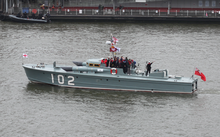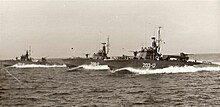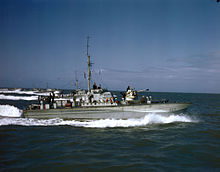
A PT boat was a motor torpedo boat used by the United States Navy in World War II. It was small, fast, and inexpensive to build, valued for its maneuverability and speed but hampered at the beginning of the war by ineffective torpedoes, limited armament, and comparatively fragile construction that limited some of the variants to coastal waters. In the US Navy they were organized in Motor Torpedo Boat Squadrons (MTBRONs).

The motor gun boat (MGB) was a small, high-speed British military vessel of the Second World War, which was armed with a mix of guns, in contrast to the physically similar motor torpedo boat (MTB), whose main offensive weapon were torpedoes. The small size of the MGBs, and their high speed, made them difficult targets for German E-boats, though, like their opponents, they were limited by heavy weather, because they did not provide a stable-enough platform to aim the guns. The large number of guns meant the crew was relatively large, numbering as high as thirty men on the largest boats.

A fast attack craft (FAC) is a small, fast, agile, offensive, often affordable warship armed with anti-ship missiles, gun or torpedoes. FACs are usually operated in close proximity to land as they lack both the seakeeping and all-round defensive capabilities to survive in blue water. The size of the vessel also limits the fuel, stores and water supplies. In size they are usually between 50–800 tonnes and can reach speeds of 25–50 knots (46–93 km/h).
Vosper & Company, often referred to simply as Vospers, was a British shipbuilding company based in Portsmouth, England.
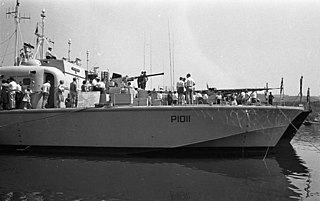
The Brave-class fast patrol boats were a class of two gas turbine motor torpedo boats (MTBs) that were the last of their type for the Royal Navy (RN) Coastal Forces division. They formed the basis for a series of simpler boats which were widely built for export.

HMS H21 was a British H class submarine built by Vickers Limited, Barrow-in-Furness, as the first of the Batch 3 H class submarines. She was launched on 20 October 1917 and was commissioned on 28 January 1918. H21 was an improved design of the H class which produced a larger displacement and the latest 21 inch torpedo tubes replacing the old 18 inch torpedo tubes. This would be incorporated into all batch 3 H class submarines. HMS H21 was sold to John Cashmore Ltd on 13 July 1926 for scrapping at Newport.

The Fairmile B motor launch was a large class of motor launch built by British boatbuilder Fairmile Marine and others during the Second World War to meet the Royal Navy's coastal operation requirements.

The Fairmile D motor torpedo boat was a type of British motor torpedo boat (MTB) and motor gunboat (MGB) designed by Bill Holt and conceived by Fairmile Marine for the Royal Navy. Nicknamed "Dog Boats", they were designed to combat the known advantages of the German E-boats over previous British coastal craft designs. They were bigger than earlier MTB or motor gunboat (MGB) designs but slower, at 30 knots compared to 40 knots.

Coastal Forces was a division of the Royal Navy initially established during World War I, and then again in World War II under the command of Rear-Admiral, Coastal Forces. It remained active until the last minesweepers to wear the "HM Coastal Forces" cap tally were taken out of reserve in 1968. The division received more gallantry awards than any other branch of the Royal Navy during that period.

Steam gun boats (SGBs) were small Royal Navy vessels built from 1940 to 1942 for Coastal Forces during the Second World War. The class consisted of nine steam-powered torpedo boats.

The Coastal Forces of the Royal Canadian Navy (RCN) was a specialized naval force of well-armed, small and fast motor launch (ML) and motor torpedo boat (MTB) flotillas, primarily manned by members of the Royal Canadian Naval Volunteer Reserve (RCNVR). Tasked with escort, coastal defence, anti-submarine, minesweeping and search and rescue duties, the Coastal Forces of the RCN contributed to securing Allied sea lines of communication off the coasts of Canada and Britain during the Second World War.
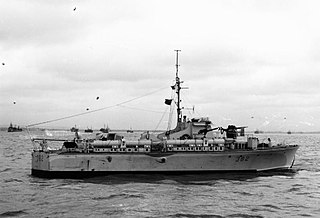
The Vosper 73 foot Motor Torpedo Boat was a mid-twentieth century British motor torpedo boat (MTB) designed by Vospers that served in the Royal Navy Coastal Forces during the Second World War.

Coastal Motor Boat was a small high-speed British torpedo boat used by the Royal Navy in the First World War and up to end of the Second World War.

The Gay class were a class of twelve fast patrol boats that served with the Royal Navy from the early 1950s. All were named after types of soldiers or military or related figures, prefixed with 'Gay'. The class could be fitted as either motor gun boats or motor torpedo boats, depending on the type of armament they carried.

The Uskok class was a class of two motor torpedo boats built for the Royal Yugoslav Navy during the late 1920s. Named Uskok and Četnik, the boats were built by the Thornycroft Company based on their existing class of 17-metre-long (55 ft) Coastal Motor Boats, but were almost 1.5 metres (5 ft) longer. As their main armament they were equipped with cradles that carried two British-designed 456-millimetre (18 in) torpedoes, were fitted with hydrophones, and could carry depth charges instead of torpedoes if used in an anti-submarine role. The boats were lightly-built using mahogany, powered by two petrol engines, but lacked transverse bulkheads within the hull to mitigate leaks.
The MT class were eight motor torpedo boats that served with the Yugoslav Navy post-World War II. They were originally built for the United States Navy by Higgins Industries as patrol torpedo boats, and served in the Mediterranean Sea with them, before being transferred to the Royal Navy at Malta in late 1944. All survived the war to be taken over by the Yugoslav Navy, with one being deleted in 1955, and the rest struck off in 1966.

The Canadian Fairmile B was a motor launch built during the Second World War for the Royal Canadian Navy. They were adaptations of the British Fairmile B motor launch design incorporating slight modifications for Canadian climatic and operational conditions. Eighty-eight were built in Canada for service with the Coastal Forces of the Royal Canadian Navy in home waters, of which eight were supplied to the United States Navy.

Harbor Boat Building Company was a shipbuilding company on Terminal Island in San Pedro, California. To support the World War II demand for ships General Engineering built: minesweepers, torpedo boats, submarine chasers, and air-sea rescue boats. In 1919 Romolo Rados founded Harbor Boat Building. After the war he renamed the company Harco Shipyard and built and sold a standard design motor boat. In 1959 he sold the company to LTV. The shipyard was closed and the company was sold again in 1971 to Omega-Alpha, Inc. The last ship built was in 1965 for the US Navy. The shipyard was located at 263 Wharf St, San Pedro.
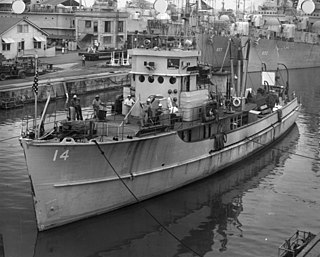
South Coast Shipyard was a shipbuilding company in Newport, California. To support the World War II demand for ships South Coast Shipyard built: minesweepers, Torpedo Boats, Submarine chasers, & Air-sea rescue boats. South Coast Shipyard was opened in 1938 by Walton Hubbard. After World War II the shipyard continued to build ships for the US Navy till 1955. The shipyard was located at 2300 Newport Boulevard, Newport, California. The shipyard closed in 1963.

Splinter fleet or Splinter navy was a nickname given to the United States wooden boats used in World War II. The boats served in many different roles during the war. These boats were built in small boatyards on the West coast and East coast, Great Lakes and the Gulf of Mexico. They could be built quickly, in just 60 to 120 days. Most of the boats were built by boatyards that already had the tools and knowledge from building yachts, sailboats and motor boats. Many were built by craftsmen in family-owned small businesses. Under the Emergency Shipbuilding Program and War Shipping Administration contracts went out to over fifty boatyards across the country. The boats were built for the US Navy, the United States Army Air Forces, United States Coast Guard, and US Army. Some of the wooden boats went to Allied nations on the Lend-Lease program.
